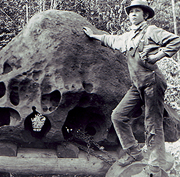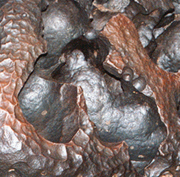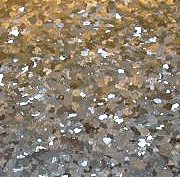Official Name:
Willamette takes its name from the river and the town near which the meteorite was found.
Location:
Some 10 kilometres from Portland in the upper Willamette Valley, Oregon, USA.
Fall or Find:
It is a find. The fall dates back to more than 13 000 years ago.
Date:
Found by a European immigrant in the autumn of 1902 but already known to native people.
Mass Recovered:
Willamette weighs 15.5 metric tons. This is the largest meteorite ever found in the United States.
Number of Fragments:
A single bell-shaped fragment was found. It measures 1.4 metres high by 3.15 metres wide. It is an oriented meteorite. The meteoroid had a stable aerodynamic form and always presented the same face while travelling through the atmosphere.
Crater:
Normally, a meteorite weighing several tons creates a huge impact crater when it collides with the Earth. When the Willamette meteorite was discovered, it was only partially embedded in the loose soil. What's more, it was lying upside down in relation to its fall position. Willamette did not fall in Oregon-it was taken there! During the last glacial period, the meteorite probably fell farther north in an area that would become part of Canada. It was imprisoned in a glacier that moved southwards before melting. As it was carried through the ice, Willamette lost close to 6 metric tons of meteoritic matter.

Enlargement
The meteorite was loaded on a sturdy cart to transport it. The discoverer, Ellis Hughes, is the man standing behind the wagon. |
|
Circumstances:
In the autumn of 1902, Ellis Hughes was cutting wood when he found an immense rock partially buried. A former miner, he immediately identified it as an iron mass and was sure it was a meteorite. Hughes wanted to move it to his land and make a profit from it. He cleared a road to his place and built a sturdy cart-pulled forward with the aid of a capstan (a vertical cylinder used to wind a cable)-to move the massive meteorite. It took Hughes, helped by his 15-year old son and his old horse, 3 months to cover the kilometre between the discovery site and his property. Hughes then built a shed around the meteorite and charged 25¢ to curious visitors who wanted to see the astonishing mass of iron.
Unfortunately for him, the meteorite had been found on the land belonging to the Oregon Iron and Steel Company. The company sued and won. Several other suits and appeals followed, but the meteorite remained the property of the company.
The meteorite was exhibited at the 1905 world's fair in Portland (the "Lewis and Clark Centennial and American Pacific Exposition and Oriental Fair"). Thousands of people came to admire it, and many wondered where the meteorite would be kept. Finally, Mrs. William E. Dodge bought Willamette from the mining company for $26 000 US. She then donated it to the American Museum of Natural History in New York City where the meteorite has been on display ever since.
History:
For the Clackamas native people, this mass of metal was a sacred object fallen from the Moon. Before each battle, warriors dipped their arrows into water collected in the cavities of the meteorite.
Type:
Iron meteorite
Class:
Medium octahedrite (1-millimetre bands)
Group:
IIIAB

Enlargement
The Willamette meteorite on exhibit at the Hayden Planetarium. Today it is on display at the Rose Center for Earth and Space of the American Museum of Natural History, New York. |
|

Enlargement
Slice of the Willamette meteorite on display at the Naturhistorisches Museum in Vienna. |
|
Composition:
This meteorite is mainly composed of iron. It also contains 7.6% nickel, 18.6 parts per million gallium, 37.3 ppm germanium, and 4.7 ppm iridium. The top of Willamette is smooth, while the base is pierced with cavities. These were troilite nodules that partially melted during the crossing, then totally disintegrated over time.
The complex microscopic structure of the meteorite preserves the traces of two major impacts. Its recrystalized texture is evidence of a first collision that separated it from the metallic core of an asteroid. The presence of Neumann bands points to a second, less violent impact. This was probably the collision that sent the meteoroid on a new, Earth-crossing orbit.
Comments:
For a long time, the native tribes of Oregon demanded the meteorite be repatriated to their lands. The American Museum of Natural History recently signed an historic agreement that acknowledges the spiritual relationship these tribes have with the meteorite and allows them privileged access for certain religious ceremonies. In exchange, the Native Americans in Oregon have agreed to allow the meteorite to remain in the Museum.
Part of the Planétarium's collection:
No